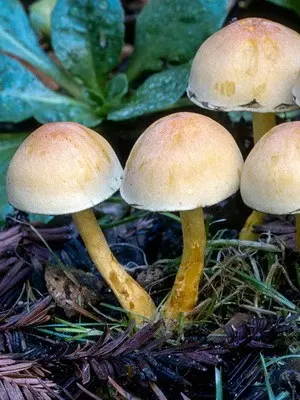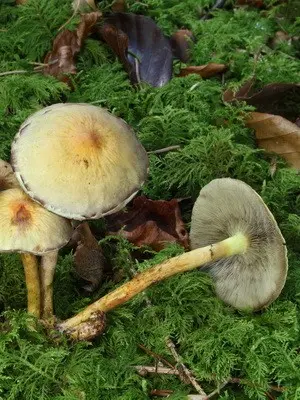Contents
- What is the difference between false honey agaric sulfur-yellow and edible species
- What does a false brick-red honey agaric look like (with photo)
- How to distinguish false mushrooms from normal edible ones (with photo and video)
- How else to recognize whether false mushrooms are or not: distinguishing features
 Fruiting bodies are found both in the wild and in the household. And honey agaric is no exception – their mycelium reproduces quickly enough and continues to live for several years. Therefore, it is so convenient to collect them in the forest or breed artificially. And besides, “hunting” honey mushrooms is a real pleasure, because it is a “collective” mushroom that cannot stand loneliness and grows in groups in one small area. However, along with edible mushrooms, there are also false representatives that can harm health and even threaten life.
Fruiting bodies are found both in the wild and in the household. And honey agaric is no exception – their mycelium reproduces quickly enough and continues to live for several years. Therefore, it is so convenient to collect them in the forest or breed artificially. And besides, “hunting” honey mushrooms is a real pleasure, because it is a “collective” mushroom that cannot stand loneliness and grows in groups in one small area. However, along with edible mushrooms, there are also false representatives that can harm health and even threaten life.
In the mushroom business, the main thing is not to rush, and also pay attention to the appearance and smell of the fruiting bodies. Every lover of “silent hunting” should take as a basis an important rule: “If in doubt, don’t take it!”. If you ignore it, then the risk of putting a false honey agaric in your basket immediately increases. Experiments in this case can play a cruel joke on you. You need to collect only those mushrooms in which you are completely sure. To do this, you need to familiarize yourself with how to identify false and normal mushrooms.
In nature, there are several types of false mushrooms that can be confused with edible ones. Among them, the most common are sulfur-yellow and brick-red honey agarics. Their caps are painted in a brighter color, while real representatives have noticeable soft and nondescript shades of the fruiting body. The following photos and descriptions of false mushrooms will tell you more about these features.
[ »wp-content/plugins/include-me/ya1-h2.php»]
What is the difference between false honey agaric sulfur-yellow and edible species
[ »»]
This type of fruiting body is a dangerous “guest” in your basket. If the mushroom that you want to put in your basket even remotely resembles a sulfur-yellow honey agaric, it is better to refuse it. Since this mushroom is considered poisonous, it is imperative to know how false mushrooms differ from edible ones.
Latin name: Hypholoma fasciculare.
Sort by: Hypholoma.
Family: Strophariaceae.
Hat: with a diameter of 3-7 cm, in young – bell-shaped. With age, it changes and becomes prostrate, acquiring a shape resembling an open umbrella. The color corresponds to the name: gray-yellow, yellow-brown. The center of the cap is darker (sometimes reddish-brown), the edges are lighter.
Leg: smooth, cylindrical, up to 10 cm high and up to 0,5 cm thick. Hollow, fibrous, light yellow in color.
Pulp: light yellow or whitish, with a pronounced unpleasant odor and bitter taste.
Records: thin, densely spaced, often attached to the stem. At a young age, the plates are sulfur-yellow, then acquire a greenish tint, and finally become olive-black.
Pay attention to the photo, where you can see how the false sulfur-yellow mushrooms look like:


Edibility: poisonous mushroom. When eaten, it causes poisoning, up to fainting.
Spread: practically throughout the Federation, except for permafrost zones. It grows in whole groups from mid-June to early October. Found on decaying deciduous and coniferous trees. It also grows on stumps and on soil near tree roots.
[ »]
What does a false brick-red honey agaric look like (with photo)
[ »wp-content/plugins/include-me/goog-left.php»]
Another representative of false species is mushrooms, on the edibility of which it is impossible to come to a consensus. In our territory, it is considered poisonous, while in Canada, Italy and Germany, brick-red honey agaric is freely eaten. Its description will help you see how false mushrooms differ from edible mushrooms.
Latin name: Hypholoma sublateritium.
Sort by: Hypholoma.
Family: Strophariaceae.
Hat: rounded-convex, spherical, prostrate with age. From 4 to 8 cm in diameter (sometimes up to 12 cm), thick, fleshy, red-brown, rarely yellow-brown. The center of the cap is darker, and white flakes can often be seen around the edges – the remains of a private bedspread.
Leg: smooth, dense and fibrous, as it grows older it becomes hollow and curved. Up to 10 cm long and 1-1,5 cm thick. The upper part is bright yellow, the lower part is red-brown.
Pulp: dense, whitish or dirty yellow, bitter in taste and unpleasant in smell.
This type of fruiting body can be clearly seen in the photo showing false and normal mushrooms:


Records: frequent, narrowly grown, light gray or yellow-gray. With age, the color changes to gray-olive, sometimes with a purple tint.
Edibility: popularly considered a poisonous mushroom, although in most sources brick-red honey agaric is classified as a conditionally edible mushroom.
Spread: Eurasia and North America. It grows on decaying stumps, branches and trunks of deciduous trees.
How to distinguish false mushrooms from normal edible ones (with photo and video)
First of all, you need to thoroughly prepare in order to know which mushrooms you met in the forest – false or not, and how to recognize them among the edible representatives of the fruiting bodies? The main trick of all false mushrooms lies in the following: they grow in the same places and in the same seasons as edible ones. Sometimes they even intertwine with each other on stumps, branches and trunks of fallen trees.
Color
In fact, a poisonous mushroom is not so difficult to distinguish from a real one. To do this, you should carefully consider its appearance. As already mentioned, edible mushrooms have a more “modest” color, in contrast to false ones. Often the latter are immediately striking, because their hats are painted in brick red, honey brown and orange. However, this is not all the signs of false mushrooms.
Skirt
The first and most important difference that you need to pay attention to is the presence of a skirt ring on the leg of the fruiting body. All types of edible mushrooms necessarily have such a ring, but false representatives do not have such a characteristic feature. Pay attention to the photo, which shows how to distinguish false mushrooms from real mushrooms by the presence of a skirt ring:


However, it should be noted that adults and overgrown specimens may lose this trait. Therefore, in this case, it is worth paying attention to other known differences.
Smell
The next important difference between false and edible mushrooms is the smell. Just cut off the mushroom or slightly break the hat: real honey agaric has a pleasant aroma, which cannot be said about false species. The latter emit the smell of mold, soil and rotten grass.
We also suggest watching a video about false and edible mushrooms:
How else to recognize whether false mushrooms are or not: distinguishing features
Scales
The caps of real mushrooms are completely or partially covered with scales, while false mushrooms have completely smooth hats. The exception is winter honey agaric, however, during its fruiting season (winter) it is impossible to meet other types of fruiting bodies. However, you should also not forget that as the real mushrooms grow older, such scales disappear.
Records
Look under the hats of the collected mushrooms: in edible species, the plates have a delicate cream or white-yellow color, while the plates of false representatives are painted in a dirty yellow or yellow tint. With age, the plates of inedible mushrooms become greenish or dirty brown.
Look at a few more photos of false and edible mushrooms to determine how to distinguish them by their external features:




Taste
The pulp of false mushrooms for the most part has a bitter taste. However, trying them, and even more so biting off a piece to determine whether you can take it to your basket, is highly discouraged! The signs described above should be enough to understand exactly how to behave with one or another type of fruiting body.
An experienced mushroom picker can immediately determine the edibility of a mushroom, but beginners who like “quiet hunting” should apply their knowledge with great care!









